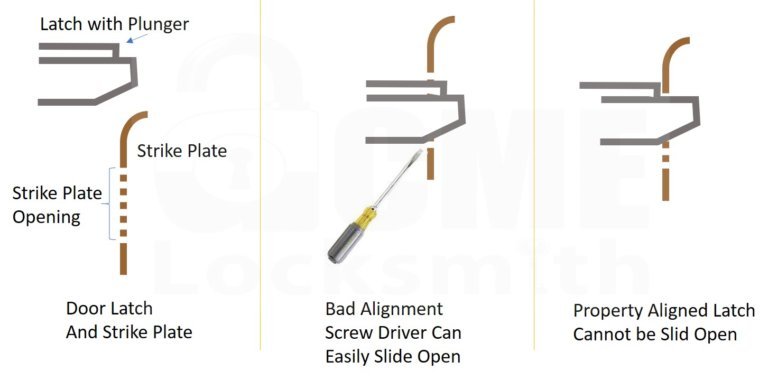
Let’s dive into the intricacies of diagnosing issues with the deadlock plunger. We’ll cover everything from what a deadlock plunger is, to common issues that arise, and how you can troubleshoot those problems. Whether you’re dealing with a simple jam or something more complex, you’ll have the knowledge to tackle it. This guide applies to various door latch types, including popular brands like Schlage and Kwikset.
Understanding the Deadlock Plunger
The deadlock plunger is a small but critical component in your door latch mechanism. Think of it as the piece that secures your door, preventing it from being opened from the outside when locked. When you turn your key or press your remote, the plunger moves to either engage or disengage the lock. If it’s working smoothly, you won’t even notice it’s there. But when things go awry, that’s when the trouble starts.
You might be wondering how this little guy can cause such a big problem. Well, like any mechanical part, it can get stuck, wear out, or malfunction over time. Age, weather conditions, and even dirt can contribute to the plunger’s performance. If you’ve noticed that your door isn’t locking or unlocking as it should, it’s time to pay attention to this crucial component.
Common Symptoms of a Failing Deadlock Plunger
Identifying symptoms of a problematic deadlock plunger can save you time and frustration. Here are a few tell-tale signs that something might be off:
- Difficulty locking or unlocking: If you feel resistance when turning the key or pressing the remote, that’s a red flag.
- Unusual noises: If you hear grinding, clicking, or popping sounds when operating the lock, that’s often a sign of wear.
- Visible damage: Check for any cracks or breaks in the plunger or surrounding parts.
When these symptoms appear, it’s essential to diagnose the issue promptly. Letting it slide could lead to more significant problems down the road, including emergency lockouts or security risks.
Tools You’ll Need for Diagnosis
Before you dive into diagnosing your deadlock plunger, gather some essential tools. You don’t need anything fancy, but having the right equipment makes the job much smoother. Here’s a quick list:
- Screwdriver: To access the latch mechanism.
- Pliers: Useful for gripping and maneuvering small parts.
- Lubricant: A silicone-based lubricant can help ease any jams.
- Flashlight: For a better view of the internal workings of the latch.
Having these tools handy ensures you can troubleshoot effectively. It’s like having a first-aid kit for your door latch issues—ready to go when you need it.
Troubleshooting Steps for the Deadlock Plunger
Now that you’re equipped with tools and knowledge, let’s walk through the troubleshooting process step-by-step.
1. Inspect the Latch Mechanism: Start by removing the latch plate with your screwdriver. Check for any visible debris or damage around the plunger area. A good visual inspection is often where you’ll spot problems.
2. Test the Plunger Movement: Use your pliers gently to test the plunger’s movement. It should slide smoothly in and out. If it’s stuck, you may need to clean or lubricate it.
3. Apply Lubricant: If the plunger isn’t budging, apply a small amount of lubricant. Avoid overdoing it, as excess lubricant can attract dirt and cause more problems.
4. Reassemble and Test: After cleaning and lubricating, reassemble the latch and test it. Check how it engages and disengages. If everything feels smooth, you’re likely back in business!
If you’ve gone through these steps and the issues continue, it might be time to consider replacing the deadlock plunger entirely.
When to Seek Professional Help
Sometimes, troubleshooting can only go so far. If you’ve tried everything and your deadlock plunger still isn’t functioning, it might be time to call in a professional. Here are a few indicators that it’s best not to go it alone:
- Extensive damage: If you notice cracks, warping, or significant wear, it might be more than just a simple fix.
- Continued locking issues: If your door remains unreliable even after your troubleshooting efforts, a pro can get to the heart of the matter.
- Emergency situations: If you find yourself locked out or in need of immediate help, contact a locksmith rather than attempting a DIY fix.
A licensed professional can not only diagnose the problem accurately but also provide solutions that ensure your door functions smoothly again.
Preventative Measures for Longevity
After diagnosing and potentially fixing your deadlock plunger, you might wonder how to keep it in tip-top shape. Here are a few *preventative measures* to extend its lifespan:
- Regular Maintenance: Periodically clean and lubricate the plunger to keep debris at bay. Quick preventive care can save you time in the long run.
- Watch for Weather Changes: Extreme temperatures can affect your lock. If you live in a particularly cold or humid area, consider checking the lock more frequently during those seasons.
- Test the Lock Regularly: Make it a habit to test your door latch every few months. A quick turn of the key can help you catch problems early.
By incorporating these steps into your routine, you can enjoy peace of mind knowing your door latch is working as it should.
Diagnosing issues with your door latch’s deadlock plunger doesn’t have to be overwhelming. With some basic tools and a little patience, you can identify most problems and even fix them on your own. Remember, the key is to keep an eye out for signs of trouble, act quickly, and take preventive measures to keep everything running smoothly.
So, whether you’re dealing with a stubborn plunger or just want to improve your door’s security, you now have the know-how to tackle the challenge. With this guide in hand, you’re ready to ensure your door is as secure and functional as it can be!